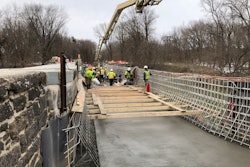Within the last three to five years, the International Powered Access Federation (IPAF), as well as aerial work platform manufacturers, have taken training from the classroom to virtually any place in the world, thanks to advancements in eLearning. Self-paced computer-based modules, university-like online training with an instructor, and programs that simulate real-life applications have made training more accessible and, in many ways, more effective.
This evolution - or revolution - in training accessibility and methodology is based in part on people becoming more accustomed to getting their information online, notes Rick Smith, senior director product training, JLG Industries Inc. “It’s a pretty exciting time right now with training. Sales of PCs and iPads are almost even today, and if you plug in sales of smart phones, PCs are blown away. As a trainer, if you’re not tuned into mobile devices you’re missing the boat.”
This media has opened up training doors that previously were locked tight. JLG, for example, now offers more than 25 eLearning courses in 16 different languages around the world. Its library consists of entry-level product courses that take 20 to 30 minutes to complete, all the way to eight-to-10-hour service modules. The company also offers an online simulator training program that places the trainee in a virtual work environment.
Genie introduced its Genie Lift Pro Online Aerial Work Platform course at the The Rental Show in February 2013, followed by a Spanish version in October of the same year. The Genie Lift Pro Online Telehandler course was launched in June 2014, followed by the Spanish version in December.
“Online learning benefits a wide range of individuals,” relates Scott Owyen, Genie global training manager. “People located in remote areas where training simply isn’t available, who cannot afford to take time from work to attend traditional classes, or who require immediate access to training are among beneficiaries. So, too, are companies with few employees or those that consistently bring on new hires."
Beyond logistics
Trainers like Owyen and Smith emphasize that online learning benefits transcend location and availability. “Trainees receive consistent information unclouded by interpretation or the variable messaging common with classroom-based or webinar-based training,” says Owyen. “Everyone also learns at his or her own pace, and unlike traditional classroom courses, online courses allow the trainee to take as much time as necessary to receive a high-quality and meaningful learning experience.”
Adds Smith, “With eLearning you can keep trainees engaged and involved with various exercises, something more difficult to accomplish in a classroom environment where there is a strict lecture format. Instructors can still play a valuable role, however, as trainees can post questions to them.”
Bolt Learning has developed training modules for IPAF. Tamlin Roberts, CEO of Bolt Learning, points to other eLearning training attributes. “eLearning can be tailored to the needs of the learner. The monitoring and reporting is far more effective, too, allowing companies to track the progress of individual trainees at any point throughout the training.“
In most instances, as is the case with our IPAF modules, the training is part of a blended approach, with eLearning covering the theoretical aspect of the subject matter. This enables more time with the trainer for the practical side of the training.
”United Rentals is also using the blended approach to training with its United Academy online training center, which was launched in 2014 and is now accessible in English, French and Spanish at UnitedAcademy.ur.com.
Jim Dorris, vice president of health, safety, environment and sustainability for United Rentals, says, “Blended learning is an emerging eLearning model that creates a synergy between pure-play online training and hands-on trainee experience. Our blended learning programs are currently being expanded to include operator training for powered industrial trucks, dirt equipment and fall protection, with a planned launch later this year.”
The full United Academy curriculum encompasses a wide range of courses related to jobsite safety and compliance, including operator certifications for aerial and excavation equipment, OSHA 10-hour and 30-hour classes, confined space entry and competent person training, and train-the-trainer certification.
How learners learn
Roberts emphasizes that people learn in different ways. For example, some are more comfortable in a reading/writing environment whereas others benefit from activities. These individuals are known as kinesthetic learners. “Old-fashioned eLearning, by presenting content in a text format only, suits reading/writing learners. Kinesthetic learners acquire more skills and information through practical exercises. They would benefit most from click-and-reveal and drag and drop activities as well as educational games and interactive videos that prepare them for real life.
”It’s not only the manner in which you are presenting the information but how trainees are using it that makes a difference, he adds. “Retention is created by processing the information, doing something with it by answering a question or sorting items into groups, and practicing. The more you practice something, the more likely you are to remember it.
“There is a point where the information or skill moves from a conscious recall and becomes part of your subconscious (for example, riding a bike). This is where eLearning comes into its element. If trainers can provide a way for trainees to practice or use the knowledge then they can assist with increasing retention.”
JLG’s simulator program, available for the 800S telescoping boom lift, the G10-55A telehandler, and the 1850SH telescoping boom, is an example. “All the controls work just like those on a boom lift or telehandler,” explains Smith. “Two joysticks allow an operator to maneuver height and reach, and also drive the machines. Everything is to scale, and the module offers two views: one from the operator’s perspective and a second external side view of the equipment.“
The simulator reduces the learning curve for first-time operators. After spending time with the program, they not only know where the controls are but what they do. If you’ve ever observed new boom lift operators, most will initially pull the joy stick the wrong way. This won’t happen with someone who has learned on the simulator. The program helps with safety training, too. For example, if the operator approaches too close to a power line, it shuts down.”
Roberts believes eLearning can be used to not only make operators more aware of potential hazards, but also to reinforce safe habits. “Over the last few years, we’ve developed a series of training modules aimed a seasoned workers in the construction and utilities industries. Short films that show the consequences of complacency and cutting corners are followed by modules that explain the reasons behind the tragic accident.
“The aim is to approach safety from a totally different direction through a hard-hitting and emotionally powerful film that demonstrates what can and does happen and how an accident impacts a person for the rest of his life."
Growing acceptance
Online learning hasn’t replaced the classroom yet, and it likely won’t in the near term. “Different learning styles can be accommodated in a classroom quite successfully, but it requires a significant amount of work, preparation, and resources to be done consistently,” remarks Roberts. “Most significant, classroom instruction relies on individual trainers to pick up on different learning styles and fashion their presentation accordingly.
“Delivery through eLearning allows trainees to explore information in a way that best suits their learning style. I wouldn’t necessarily say that eLearning can accommodate learning styles better than classroom training, but it can certainly do it more easily.”
The other question is the level of acceptance by learners. “Initially, there was some hesitancy because the technology was new,” says Owyen. “But the programs have proven themselves and are now being embraced by the industry. Since its launch, more than 5,000 operators have been trained using Genie Lift Pro. Customers love having the ability to provide immediate access to high-quality training 24 hours, seven days a week. Many of our customers use the online courses for their own internal training needs in addition to selling it to their own customers.”
Having access to training is certainly key to the current success of online education and eLearning. But it is how this access works in concert with new training methodology and concepts that will take it to the next level.



















